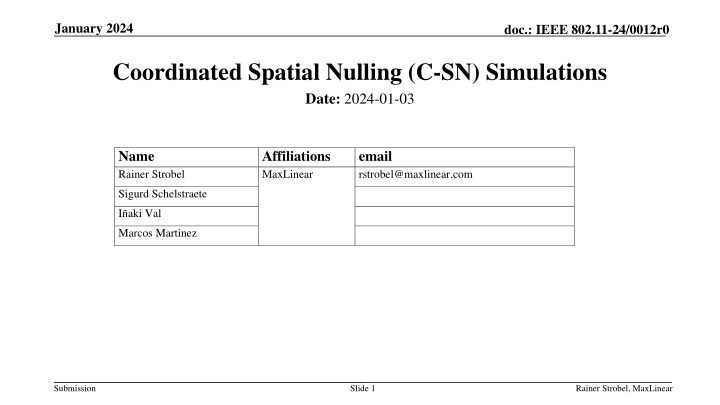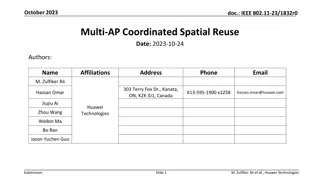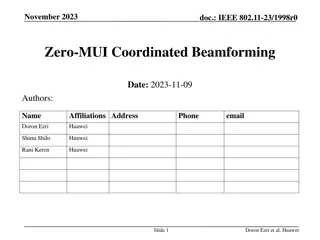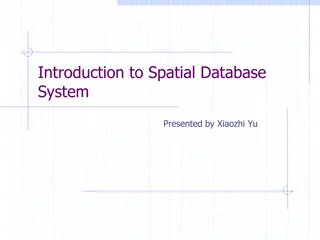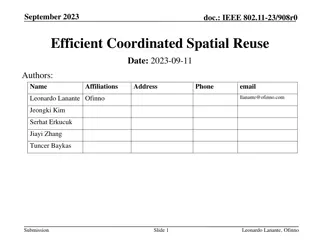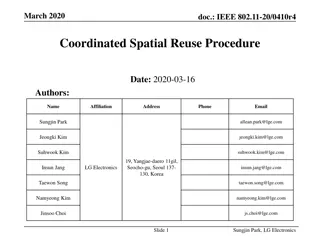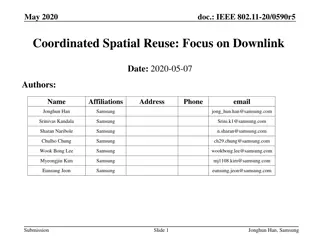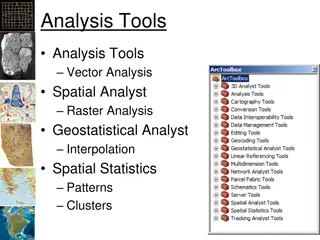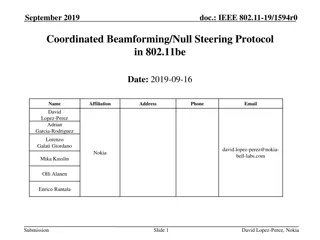Coordinated Spatial Nulling (C-SN) Simulations in IEEE 802.11-24/0012r0
The document discusses the concept of Coordinated Spatial Nulling (C-SN) in IEEE 802.11-24/0012r0, focusing on spatial nulling feedback, synchronization needs, advantages of partial nulling, and comparison of half-coordinated versus fully coordinated scenarios. Simulation results are presented, analyzing the performance of spatial nulling in various in-home scenarios, different precoder computation modes, coverage simulations, and aggregate throughput comparisons. It highlights that fully coordinated nulling consistently outperforms TDMA and even partial nulling can surpass TDMA under certain conditions, especially when APs are closer. The study suggests that C-SN complements C-SR in scenarios where the latter underperforms.
Download Presentation

Please find below an Image/Link to download the presentation.
The content on the website is provided AS IS for your information and personal use only. It may not be sold, licensed, or shared on other websites without obtaining consent from the author.If you encounter any issues during the download, it is possible that the publisher has removed the file from their server.
You are allowed to download the files provided on this website for personal or commercial use, subject to the condition that they are used lawfully. All files are the property of their respective owners.
The content on the website is provided AS IS for your information and personal use only. It may not be sold, licensed, or shared on other websites without obtaining consent from the author.
E N D
Presentation Transcript
January 2024 doc.: IEEE 802.11-24/0012r0 Coordinated Spatial Nulling (C-SN) Simulations Date: 2024-01-03 Name Rainer Strobel Affiliations MaxLinear email rstrobel@maxlinear.com Sigurd Schelstraete I aki Val Marcos Martinez Submission Slide 1 Rainer Strobel, MaxLinear
January 2024 doc.: IEEE 802.11-24/0012r0 Introduction The concept of coordinated spatial nulling is presented in [10], which discussed: Spatial nulling feedback Need for synchronization Advantages of partial nulling Half-coordinated vs. Fully coordinated This contribution presents simulation results Performance spatial nulling in different in-home scenarios and coordination scenarios Comparison of different precoder computation modes Submission Slide 2 Rainer Strobel, MaxLinear
January 2024 doc.: IEEE 802.11-24/0012r0 In-Home Scenarios Coverage Simulation Residential scenario based on [5] 2 AP placement options: Co-located APs 10m distance between APs 20m distance between APs In OBSS case, STAs are assigned to APs according to position (Room 1, 2 to AP1, Room 3,4 to AP2) In ESS case, STA assignment is optimized Submission Slide 3 Rainer Strobel, MaxLinear
January 2024 doc.: IEEE 802.11-24/0012r0 Simulation Assumptions For half-coordinated C-SN C-SN feedback (as in [10], slide 6) Allowed SNR degradation is 3dB At the secondary AP, all free spatial streams are used to create spatial nulls consistent with the max. SNR degradation Partial nulling is used (see [10]) Fully coordinated C-SN Joint MMSE precoder optimization (uplink-downlink duality) is used (see slide 11) Joint Sounding (as in [10], slide 8) is assumed Synchronization OFDM symbol alignment for spatial nulling [9, 10] Baseline TDMA with MU-MIMO (Denoted as TDMA in results) Slide 4 Submission Rainer Strobel, MaxLinear
January 2024 doc.: IEEE 802.11-24/0012r0 Aggregate Throughput Comparison (1) Submission Slide 5 Rainer Strobel, MaxLinear
January 2024 doc.: IEEE 802.11-24/0012r0 Aggregate Throughput Comparison (2) Observations Fully coordinated nulling always outperforms TDMA Even half-coordinated (partial) nulling outperforms TDMA with sufficient distance between the APs Most gain when APs are closer to each other Complements C-SR in scenarios where C-SR doesn t perform well Submission Slide 6 Rainer Strobel, MaxLinear
January 2024 doc.: IEEE 802.11-24/0012r0 Individual STA rates (1) Minimum distance between APs Fully coordinated C-SN, using joint precoder optimization, gives the highest rates Half-coordinated C-SN rates are lower than TDMA with access points close to each other The fairness issue observed with fully coordinated C-SR is not observed for C-SN OBSS Full Coordinated Submission Slide 7 Rainer Strobel, MaxLinear
January 2024 doc.: IEEE 802.11-24/0012r0 Individual STA rates (2) 10m distance between APs With more distance between APs, half-coordinated C-SN rates are close to TDMA rates Fully coordinated still performs best OBSS Full Coordinated Submission Slide 8 Rainer Strobel, MaxLinear
January 2024 doc.: IEEE 802.11-24/0012r0 Individual STA rates (3) 20m distance between APs No fairness issues with fully coordinated C-SN (compared to fully coordinated C-SR) STAs located close to AP2, but associated with AP1 suffer (ESS will improve) OBSS Fully Coordinated Submission Slide 9 Rainer Strobel, MaxLinear
January 2024 doc.: IEEE 802.11-24/0012r0 ESS vs. OBSS OBSS vs. ESS STA Rates STAs are associated with the closest AP (w.r.t. attenuation) Issue of low rates in room 2 resolved APs at 20m distance Submission Slide 10 Rainer Strobel, MaxLinear
January 2024 doc.: IEEE 802.11-24/0012r0 Precoder options: Mutual Nulling vs. MMSE Mutual Nulling Each AP receives C-SN feedback and performs nulling to un- associated STAs Precoder computation is done at each AP independently (see [10], appendix) Joint MMSE Precoder One of the APs or a central coordinator computes the precoder for all APs and distributes the coefficients (?) log2 1 +????,? max?? (?) APs ? stream ? carrier ? (?)?? ? ,H s.t. tr ?? ?max APs ? carrier ? Submission Slide 11 Rainer Strobel, MaxLinear
January 2024 doc.: IEEE 802.11-24/0012r0 Mutual Nulling vs. MMSE Performance Performance comparison 20m distance between APs MMSE precoder reaches significantly higher rates Reason: MMSE works efficient with Number of spatial streams > Number of TX antennas Submission Slide 12 Rainer Strobel, MaxLinear
January 2024 doc.: IEEE 802.11-24/0012r0 Conclusion Spatial nulling improves throughput, compared to MU-MIMO TDMA and "regular" C-SR, for OBSS and ESS With small to medium distance between APs, spatial nulling gives a throughput increase around 20%, compared to collision-free TDMA With larger distance between APs, 30%-50% throughput increase is possible In addition, latency is improved over TDMA by the ability to transmit with multiple APs simultaneously Joint precoder calculation gives an additional performance improvement Submission Slide 13 Rainer Strobel, MaxLinear
January 2024 doc.: IEEE 802.11-24/0012r0 References [1] Multi-AP Simulations: framework and Joint Transmission results , IEEE 802.11-23/1176r1 [2] Multi-AP Simulations: follow-up , IEEE 802.11-23/1843r0 [3] Coordinated spatial re-use for UHR , IEEE 802.11-23/1975r0 [3] Spatial Reuse in Coordinated M-AP for UHR , IEEE 802.11-23-0058r0 [4] Sigurd Schelstraete (Maxlinear), SINR-aware Spatial Reuse , IEEE 802.11-22/1970r0, November 2022 [5] Performance of C-BF and C-SR , IEEE 802.11-22/0776r1 [6] Gary Anwyl et. al Coordinated Spatial Reuse in a 4 AP Topology , IEEE 802.11-23-1023r2 [7] Kanke Wu et. al Performance of Coordinated Spatial Reuse , IEEE 802.11-23-1037r0 [8] TGax Simulation Scenarios , IEEE 802.11-14/0621r3, Simone Merlin, etc. [9] Sigurd Schelstraete et.al., Nullingand coordinated beamforming IEEE 802.11-19/0638 [10] Rainer Strobel et.al., Coordinated Spatial Nulling (C-SN) Concept IEEE 802.11-24-0011 Submission Slide 14 Rainer Strobel, MaxLinear
January 2024 doc.: IEEE 802.11-24/0012r0 APPENDIX Submission Slide 15 Rainer Strobel, MaxLinear
January 2024 doc.: IEEE 802.11-24/0012r0 Simulation parameters Value Parameter TX/RX Antennas 4/2 APs/STAs 2/4 (2 STAs per AP) Spatial streams 1 or 2 (optimized) Bandwidth 160 MHz AP TX Power 21 dBm Channel model D NLOS [8] MCS 0-13 (optimized) Frequency 5.25GHz GI 1.6 s TX/RX SNR 41dB/43dB Channel aging/Doppler 1.2km/h, 6Hz BF quantization ideal Precoder type ZF (O-BSS), MMSE (C-ESS) Sounding interval 100ms (SU), 10ms (MU) Overhead Sounding and MAC overhead not considered MU allocation 2 STAs served by one AP 50% time for per AP Submission Slide 16 Rainer Strobel, MaxLinear
January 2024 doc.: IEEE 802.11-24/0012r0 OBSS Half-Coordinated Power control and spatial nulling Secondary rates are low, but 100% available (small rate improvement, but much better latency) Co-located APs Submission Slide 17 Rainer Strobel, MaxLinear
January 2024 doc.: IEEE 802.11-24/0012r0 OBSS Half-Coordinated Half Coordinated With more distance between APs, secondary rates improve APs at 10m distance Submission Slide 18 Rainer Strobel, MaxLinear
January 2024 doc.: IEEE 802.11-24/0012r0 OBSS Half Coordinated Spatial Re-Use and Spatial Nulling Average rates improve, compared to C-SR APs at 20m distance Submission Slide 19 Rainer Strobel, MaxLinear
